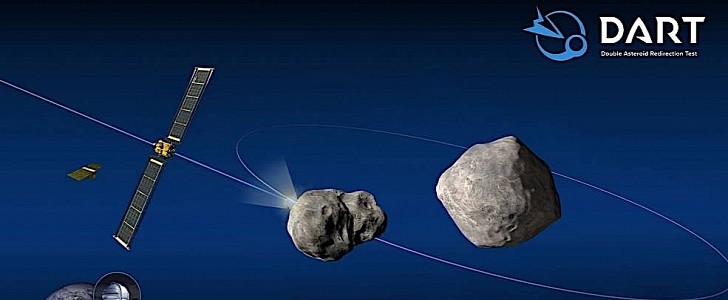After for years it ran simulations that proved humanity is nowhere near the technological level that would help us defend against killer asteroids, NASA is finally doing something about it. And that something is called DART.
DART stands for Double Asteroid Redirection Test, and it is in fact a spacecraft that will travel to space and then turn into a projectile meant to slam into an asteroid. With it, the American space agency plans to prove the idea that given enough mass and speed, we could, if need be, alter the trajectory of a rock hurtling toward our planet.
We’ve covered DART extensively over the past few years, but now we get word the mission is entering its final pre-launch stages. At the beginning of this month, DART was fitted with the Light Italian CubeSat for Imaging Asteroids (LICIACube) – the piece of technology that will monitor the spacecraft's final maneuver and impact with the asteroid.
We also got word of the launch date having been set. If the weather helps, DART will depart our planet on November 23 at 10:20 p.m. PST. Taking the thing to orbit will be a SpaceX Falcon 9 rocket, which will take off from the Vandenberg Space Force Base in California.
DART’s target is a binary asteroid called Didymos, which has a main body of 780 meters (2,560 feet) across, and a smaller, 160 meters (525 feet) across one that spins around it. It’s the smaller piece of rock DART plans to smash into at speeds of 15,000 mph (24,140 kph).
The test would prove successful if the speed and orbit of the smaller body change by at least a fraction of one percent – it may seem insignificant, but such a change translates into an orbital period of several minutes.
Proof that we humans can damage the space around us has been around for a while. In 2019, the Japanese Space Agency (JAXA) used the Hayabusa2 spacecraft to fire a high-speed slug into the surface of asteroid Ryugu, causing a crater 2 meters in diameter (6.5 feet).
Although they may seem quite violent, these experiments are required because they may open the doors to planetary defense technologies we badly need. The latest NASA simulation about an asteroid impact proved there would be nothing we can do about it at the moment, not even if we got six months advance warning.
We’ve covered DART extensively over the past few years, but now we get word the mission is entering its final pre-launch stages. At the beginning of this month, DART was fitted with the Light Italian CubeSat for Imaging Asteroids (LICIACube) – the piece of technology that will monitor the spacecraft's final maneuver and impact with the asteroid.
We also got word of the launch date having been set. If the weather helps, DART will depart our planet on November 23 at 10:20 p.m. PST. Taking the thing to orbit will be a SpaceX Falcon 9 rocket, which will take off from the Vandenberg Space Force Base in California.
DART’s target is a binary asteroid called Didymos, which has a main body of 780 meters (2,560 feet) across, and a smaller, 160 meters (525 feet) across one that spins around it. It’s the smaller piece of rock DART plans to smash into at speeds of 15,000 mph (24,140 kph).
The test would prove successful if the speed and orbit of the smaller body change by at least a fraction of one percent – it may seem insignificant, but such a change translates into an orbital period of several minutes.
Proof that we humans can damage the space around us has been around for a while. In 2019, the Japanese Space Agency (JAXA) used the Hayabusa2 spacecraft to fire a high-speed slug into the surface of asteroid Ryugu, causing a crater 2 meters in diameter (6.5 feet).
Although they may seem quite violent, these experiments are required because they may open the doors to planetary defense technologies we badly need. The latest NASA simulation about an asteroid impact proved there would be nothing we can do about it at the moment, not even if we got six months advance warning.






